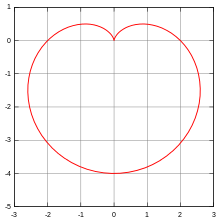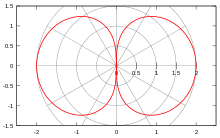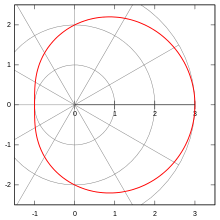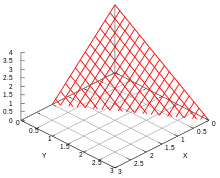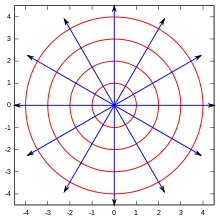Parametric Equations
1. Find parametric equations describing the line segment from P(0,0) to Q(7,17).
2. Find parametric equations describing the line segment from

to

.
3. Find parametric equations describing the ellipse centered at the origin with major axis of length 6 along the x-axis and the minor axis of length 3 along the y-axis, generated clockwise.
Polar Coordinates
20. Convert the equation into Cartesian coordinates:

21. Find an equation of the line y=mx+b in polar coordinates.
Sketch the following polar curves without using a computer.
22.

23.

24.

Sketch the following sets of points.
25.

26.

Calculus in Polar Coordinates
Find points where the following curves have vertical or horizontal tangents.
40.

41.

Sketch the region and find its area.
43. The region inside the petals of the rose

and outside the circle

Vectors and Dot Product
60. Find an equation of the sphere with center (1,2,0) passing through the point (3,4,5)
61. Sketch the plane passing through the points (2,0,0), (0,3,0), and (0,0,4)
62. Find the value of

if

and

63. Find all unit vectors parallel to

64. Prove one of the distributive properties for vectors in

:

65. Find all unit vectors orthogonal to

in

66. Find all unit vectors orthogonal to

in

67. Find all unit vectors that make an angle of

with the vector

Cross Product
Find  and
and 
80.

and

81.

and

Find the area of the parallelogram with sides  and
and  .
.
82.

and

83.

and

84. Find all vectors that satisfy the equation

85. Find the volume of the parallelepiped with edges given by position vectors

,

, and

86. A wrench has a pivot at the origin and extends along the
x-axis. Find the magnitude and the direction of the torque at the pivot when the force

is applied to the wrench
n units away from the origin.
Prove the following identities or show them false by giving a counterexample.
87.

88.

89.

Calculus of Vector-Valued Functions
100. Differentiate

.
101. Find a tangent vector for the curve

at the point

.
102. Find the unit tangent vector for the curve

.
103. Find the unit tangent vector for the curve
![{\displaystyle \mathbf {r} (t)=\langle \sin(t),\cos(t),e^{-t}\rangle ,\ t\in [0,\pi ]}](../I/m/a2f30552af99a8f55083220a2960a8a6697bad79.svg)
at the point

.
105. Evaluate

Motion in Space
120. Find velocity, speed, and acceleration of an object if the position is given by

.
121. Find the velocity and the position vectors for

if the acceleration is given by

.
Length of Curves
Find the length of the following curves.
140.
![{\displaystyle \mathbf {r} (t)=\langle 4\cos(3t),4\sin(3t)\rangle ,\ t\in [0,2\pi /3].}](../I/m/f3681f0d46ab5bdb85098ee74c0058797105aace.svg)
141.
![{\displaystyle \mathbf {r} (t)=\langle 2+3t,1-4t,3t-4\rangle ,\ t\in [1,6].}](../I/m/1513778e4cae9f336be929232f7054e2840ec58f.svg)
Parametrization and Normal Vectors
142. Find a description of the curve that uses arc length as a parameter:
![{\displaystyle \mathbf {r} (t)=\langle t^{2},2t^{2},4t^{2}\rangle \ t\in [1,4].}](../I/m/9715ec537d31fdc34e2ac352df9235bfa517bc28.svg)
143. Find the unit tangent vector
T and the principal unit normal vector
N for the curve

Check that
T⋅N=0.
Equations of Lines And Planes
160. Find an equation of a plane passing through points

161. Find an equation of a plane parallel to the plane 2x−y+z=1 passing through the point (0,2,-2)
162. Find an equation of the line perpendicular to the plane x+y+2z=4 passing through the point (5,5,5).
163. Find an equation of the line where planes x+2y−z=1 and x+y+z=1 intersect.
164. Find the angle between the planes x+2y−z=1 and x+y+z=1.
165. Find the distance from the point (3,4,5) to the plane x+y+z=1.
Limits And Continuity
Evaluate the following limits.
180.

181.

At what points is the function f continuous?
182.

183.

Use the two-path test to show that the following limits do not exist. (A path does not have to be a straight line.)
184.

185.

186.

187.

Partial Derivatives
200. Find

if

201. Find all three partial derivatives of the function

Find the four second partial derivatives of the following functions.
202.

203.

Chain Rule
Find 
220.

221.

222.

Find 
223.

224.

225. The volume of a pyramid with a square base is

, where
x is the side of the square base and
h is the height of the pyramid. Suppose that

and

for

Find

Tangent Planes
Find an equation of a plane tangent to the given surface at the given point(s).
240.

241.

242.

243.

Maximum And Minimum Problems
Find critical points of the function f. When possible, determine whether each critical point corresponds to a local maximum, a local minimum, or a saddle point.
260.

261.

262.

Find absolute maximum and minimum values of the function f on the set R.
263.

264.
 R
R is a closed triangle with vertices (0,0), (2,0), and (0,2).
265. Find the point on the plane x−y+z=2 closest to the point (1,1,1).
266. Find the point on the surface

closest to the plane

Double Integrals over Rectangular Regions
Evaluate the given integral over the region R.
280.
![{\displaystyle \displaystyle \iint _{R}(x^{2}+xy)dA,\ R=\{(x,y)\mid x\in [1,2],\ y\in [-1,1]\}}](../I/m/ed365e6e7ddc55551e813614af01d9c10cdc9af6.svg)
281.
![{\displaystyle \displaystyle \iint _{R}(xy\sin(x^{2}))dA,\ R=\{(x,y)\mid x\in [0,{\sqrt {\pi /2}}],\ y\in [0,1]\}}](../I/m/348d8c966096be3b39bffd752544bc134cb87182.svg)
282.
![{\displaystyle \displaystyle \iint _{R}{\frac {x}{(1+xy)^{2}}}dA,\ R=\{(x,y)\mid x\in [0,4],\ y\in [1,2]\}}](../I/m/e1d6288e4ccdb0134f6d2546fdd60591316f57ca.svg)
Evaluate the given iterated integrals.
283.

284.

Double Integrals over General Regions
Evaluate the following integrals.
300.
 R
R is bounded by
x=0,
y=2
x+1, and
y=5−2
x.
301.
 R
R is in the first quadrant and bounded by
x=0,

and

Use double integrals to compute the volume of the given region.
302. The solid in the first octant bound by the coordinate planes and the surface

303. The solid beneath the cylinder

and above the region
![{\displaystyle R=\{(x,y)\mid y\in [0,1],\ x\in [y,1]\}.}](../I/m/856d2cf8e1925376bee04c19cab0d5776798d7e3.svg)
304. The solid bounded by the paraboloids

and

Double Integrals in Polar Coordinates
320. Evaluate

for
![{\displaystyle R=\{(r,\theta )\mid r\in [1,3],\ \theta \in [0,\pi /2]\}}](../I/m/bd2b79af3799bfeb6786939cced1210962a85ae2.svg)
321. Find the average value of the function

over the region
![{\displaystyle \{(r,\theta )\mid r\in [2,4]\}.}](../I/m/0f34d27bc87605d3269e518c127c478a3854701e.svg)
322. Evaluate

323. Evaluate

if
R is the unit disk centered at the origin.
Triple Integrals
340. Evaluate

In the following exercises, sketching the region of integration may be helpful.
341. Find the volume of the solid in the first octant bounded by the plane 2x+3y+6z=12 and the coordinate planes.
342. Find the volume of the solid in the first octant bounded by the cylinder

for
![{\displaystyle y\in [0,\pi ]}](../I/m/0281fdf747a9247ed8a56221ddd07b34c2a50097.svg)
, and the planes
y=
x and
x=0.
343. Evaluate

344. Rewrite the integral

in the order
dydzdx.
Cylindrical And Spherical Coordinates
360. Evaluate the integral in cylindrical coordinates:

361. Find the mass of the solid cylinder
![{\displaystyle D=\{(r,\theta ,z)\mid r\in [0,3],\ z\in [0,2]\}}](../I/m/b3d5655e4f2397642509c6640400d7087e95cf35.svg)
given the density function

362. Use a triple integral to find the volume of the region bounded by the plane
z=0 and the hyperboloid

363. If
D is a unit ball, use a triple integral in spherical coordinates to evaluate

364. Find the mass of a solid cone
![{\displaystyle \{(\rho ,\phi ,\theta )\mid \phi \leq \pi /3,\ z\in [0,4]\}}](../I/m/f200079667c56d8b47444f8062308745eb385015.svg)
if the density function is

365. Find the volume of the region common to two cylinders:

Center of Mass and Centroid
380. Find the center of mass for three particles located in space at (1,2,3), (0,0,1), and (1,1,0), with masses 2, 1, and 1 respectively.
381. Find the center of mass for a piece of wire with the density

for
![{\displaystyle x\in [0,\pi ].}](../I/m/6060e8cfe67c32952064ce30d10d000735967451.svg)
382. Find the center of mass for a piece of wire with the density

for
![{\displaystyle x\in [0,4].}](../I/m/246b2cdb5a7eb4ef2a89385af8652d13e75c1afb.svg)
383. Find the centroid of the region in the first quadrant bounded by the coordinate axes and

384. Find the centroid of the region in the first quadrant bounded by

,

, and

.
385. Find the center of mass for the region
![{\displaystyle \{(x,y)\mid x\in [0,4],y\in [0,2]\}}](../I/m/9e476dabc9b7a7dfe36cd98372488912496465f7.svg)
, with the density

386. Find the center of mass for the triangular plate with vertices (0,0), (0,4), and (4,0), with density

Vector Fields
One can sketch two-dimensional vector fields by plotting vector values, flow curves, and/or equipotential curves.
401. Find and sketch the gradient field

for the potential function

.
402. Find and sketch the gradient field

for the potential function

for

and

.
403. Find the gradient field

for the potential function

Line Integrals
420. Evaluate

if
C is the line segment from (0,0) to (5,5)
421. Evaluate

if
C is the circle of radius 4 centered at the origin
422. Evaluate

if
C is the helix
![{\displaystyle \mathbf {r} (t)=\langle 3\cos(t),3\sin(t),t\rangle ,\ t\in [0,2\pi ]}](../I/m/0c08e2103ca08229383eb122b8d4d0b8dba3eac9.svg)
423. Evaluate

if

and
C is the arc of the parabola
![{\displaystyle \mathbf {r} (t)=\langle 4t,t^{2}\rangle ,\ t\in [0,1]}](../I/m/642cd051fef71427b9ff15e0885d8b70e1d1f344.svg)
424. Find the work required to move an object from (1,1,1) to (8,4,2) along a straight line in the force field

Conservative Vector Fields
Determine if the following vector fields are conservative on 
440.

441.

Determine if the following vector fields are conservative on their respective domains in  When possible, find the potential function.
When possible, find the potential function.
442.

443.

Green's Theorem
460. Evaluate the circulation of the field

over the boundary of the region above
y=0 and below
y=
x(2-
x) in two different ways, and compare the answers.
461. Evaluate the circulation of the field

over the unit circle centered at the origin in two different ways, and compare the answers.
462. Evaluate the flux of the field

over the square with vertices (0,0), (1,0), (1,1), and (0,1) in two different ways, and compare the answers.
Divergence And Curl
480. Find the divergence of

481. Find the divergence of

482. Find the curl of

483. Find the curl of

484. Prove that the general rotation field

, where

is a non-zero constant vector and

, has zero divergence, and the curl of

is

.
Surface Integrals
500. Give a parametric description of the plane

501. Give a parametric description of the hyperboloid

502. Integrate

over the portion of the plane
z=2−
x−
y in the first octant.
503. Integrate

over the paraboloid
![{\displaystyle z=x^{2}+y^{2},\ z\in [0,4].}](../I/m/41908c387a7d4b76f5e34372862a7379b14c0707.svg)
504. Find the flux of the field

across the surface of the cone
![{\displaystyle z^{2}=x^{2}+y^{2},\ z\in [0,1],}](../I/m/bdef9c8592f3f4001cfc49e3df0f914ece0b10df.svg)
with normal vectors pointing in the positive
z direction.
505. Find the flux of the field

across the surface
![{\displaystyle y=x^{2},\ z\in [0,4],\ x\in [0,1],}](../I/m/75190cd1fce58f3ae022e60f9e482de598e957cd.svg)
with normal vectors pointing in the positive
y direction.
Stokes' Theorem
520. Use a surface integral to evaluate the circulation of the field

on the boundary of the plane

in the first octant.
521. Use a surface integral to evaluate the circulation of the field

on the circle

522. Use a line integral to find

where

,

is the upper half of the ellipsoid

, and

points in the direction of the
z-axis.
523. Use a line integral to find

where

,

is the part of the sphere

for

, and

points in the direction of the
z-axis.
Divergence Theorem
Compute the net outward flux of the given field across the given surface.
540.

,

is a sphere of radius

centered at the origin.
541.

,

is the boundary of the tetrahedron in the first octant bounded by

542.

,

is the boundary of the cube

543.

,

is the surface of the region bounded by the paraboloid

and the
xy-plane.
544.

,

is the boundary of the region between the concentric spheres of radii 2 and 4, centered at the origin.
545.

,

is the boundary of the region between the cylinders

and

and cut off by planes

and

